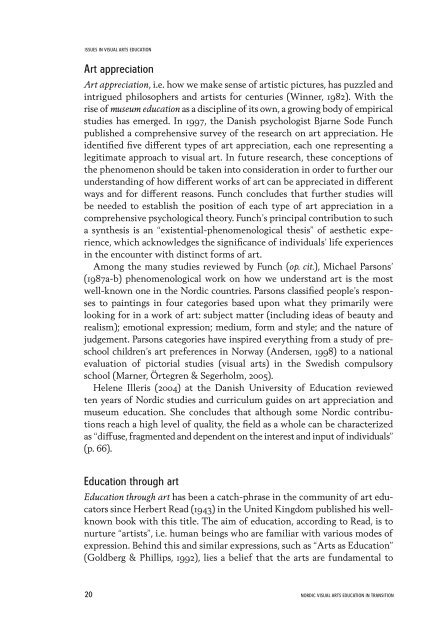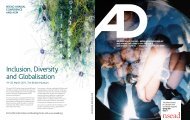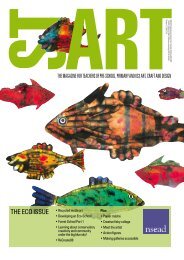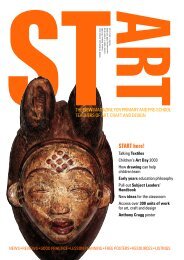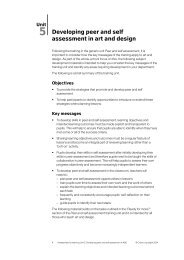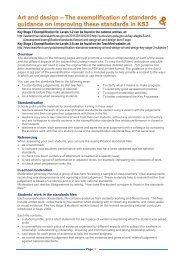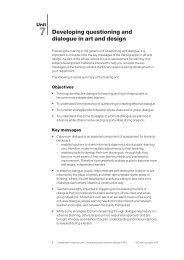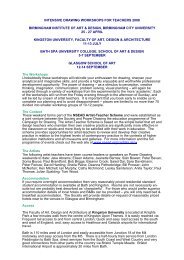Research in Visual Arts Education - Bilderlernen.at
Research in Visual Arts Education - Bilderlernen.at
Research in Visual Arts Education - Bilderlernen.at
You also want an ePaper? Increase the reach of your titles
YUMPU automatically turns print PDFs into web optimized ePapers that Google loves.
ISSUES IN VISUAL ARTS EDUCATIONArt appreci<strong>at</strong>ionArt appreci<strong>at</strong>ion, i.e. how we make sense of artistic pictures, has puzzled and<strong>in</strong>trigued philosophers and artists for centuries (W<strong>in</strong>ner, 1982). With therise of museum educ<strong>at</strong>ion as a discipl<strong>in</strong>e of its own, a grow<strong>in</strong>g body of empiricalstudies has emerged. In 1997, the Danish psychologist Bjarne Sode Funchpublished a comprehensive survey of the research on art appreci<strong>at</strong>ion. Heidentified five different types of art appreci<strong>at</strong>ion, each one represent<strong>in</strong>g alegitim<strong>at</strong>e approach to visual art. In future research, these conceptions ofthe phenomenon should be taken <strong>in</strong>to consider<strong>at</strong>ion <strong>in</strong> order to further ourunderstand<strong>in</strong>g of how different works of art can be appreci<strong>at</strong>ed <strong>in</strong> differentways and for different reasons. Funch concludes th<strong>at</strong> further studies willbe needed to establish the position of each type of art appreci<strong>at</strong>ion <strong>in</strong> acomprehensive psychological theory. Funch’s pr<strong>in</strong>cipal contribution to sucha synthesis is an “existential-phenomenological thesis” of aesthetic experience,which acknowledges the significance of <strong>in</strong>dividuals’ life experiences<strong>in</strong> the encounter with dist<strong>in</strong>ct forms of art.Among the many studies reviewed by Funch (op. cit.), Michael Parsons’(1987a-b) phenomenological work on how we understand art is the mostwell-known one <strong>in</strong> the Nordic countries. Parsons classified people’s responsesto pa<strong>in</strong>t<strong>in</strong>gs <strong>in</strong> four c<strong>at</strong>egories based upon wh<strong>at</strong> they primarily werelook<strong>in</strong>g for <strong>in</strong> a work of art: subject m<strong>at</strong>ter (<strong>in</strong>clud<strong>in</strong>g ideas of beauty andrealism); emotional expression; medium, form and style; and the n<strong>at</strong>ure ofjudgement. Parsons c<strong>at</strong>egories have <strong>in</strong>spired everyth<strong>in</strong>g from a study of preschoolchildren’s art preferences <strong>in</strong> Norway (Andersen, 1998) to a n<strong>at</strong>ionalevalu<strong>at</strong>ion of pictorial studies (visual arts) <strong>in</strong> the Swedish compulsoryschool (Marner, Örtegren & Segerholm, 2005).Helene Illeris (2004) <strong>at</strong> the Danish University of <strong>Educ<strong>at</strong>ion</strong> reviewedten years of Nordic studies and curriculum guides on art appreci<strong>at</strong>ion andmuseum educ<strong>at</strong>ion. She concludes th<strong>at</strong> although some Nordic contributionsreach a high level of quality, the field as a whole can be characterizedas “diffuse, fragmented and dependent on the <strong>in</strong>terest and <strong>in</strong>put of <strong>in</strong>dividuals”(p. 66).<strong>Educ<strong>at</strong>ion</strong> through art<strong>Educ<strong>at</strong>ion</strong> through art has been a c<strong>at</strong>ch-phrase <strong>in</strong> the community of art educ<strong>at</strong>orss<strong>in</strong>ce Herbert Read (1943) <strong>in</strong> the United K<strong>in</strong>gdom published his wellknownbook with this title. The aim of educ<strong>at</strong>ion, accord<strong>in</strong>g to Read, is tonurture “artists”, i.e. human be<strong>in</strong>gs who are familiar with various modes ofexpression. Beh<strong>in</strong>d this and similar expressions, such as “<strong>Arts</strong> as <strong>Educ<strong>at</strong>ion</strong>”(Goldberg & Phillips, 1992), lies a belief th<strong>at</strong> the arts are fundamental to20 NORDIC VISUAL ARTS EDUCATION IN TRANSITION


